Performance Assessment Indicators for Comparing Recreational Services of Urban Parks
Abstract
1. Introduction
2. Materials and Methods
2.1. Performance Assessment Indicators for Recreational Services of Urban Parks
2.2. Study Sites and the Spatial Attributes of the Case Parks
2.3. Data Collection and Analysis
2.3.1. Systematic Observation
2.3.2. Questionnaire Survey
2.3.3. Recreational Area Calculation
3. Results
3.1. Number of Participants (Nri)
3.2. Average Satisfaction Level ( and )
3.3. Performance of Recreational Services (PR)
4. Discussion
4.1. Difference of Indicators in Revealing Parks’ Recreational Services
4.2. Inference Based on the Performance Comparison of Parks’ Recreational Services
4.3. The Implication for Refined Park Design and Management
4.4. Limitations and Future Developments
5. Conclusions
Author Contributions
Funding
Institutional Review Board Statement
Informed Consent Statement
Data Availability Statement
Acknowledgments
Conflicts of Interest
Appendix A




Appendix B
| XX Park Recreation Usage Observation Record Sheet | ||
|---|---|---|
| Recreation space unit codes: | ||
| A. XXX zone B. XXX zone C. XXX zone ⋯⋯ N. XXX zone | ||
| Recreation space node codes: | ||
| a. landscape architecture | ||
| b. square or open space | ||
| c. water platform | ||
| d. landscape bridge | ||
| e. stone setting | ||
| f. flower ponds or flower paths | ||
| g. landscape paths | ||
| h. fitness trails | ||
| i. artificial facilities | ||
| DATE: | ||
| PLACE: | ||
| WEATHER: | ||
| Time range: | ||
| Space unit zone | Space node | User numbers with demographic characteristics and recreational activity engaged in |
| A1 (Attached with space nodes of the unit plan) | A1 a1 | |
| ⋯ | ⋯ | |
| NX (Attached with space nodes of the unit plan) | NX nx | |
Appendix C
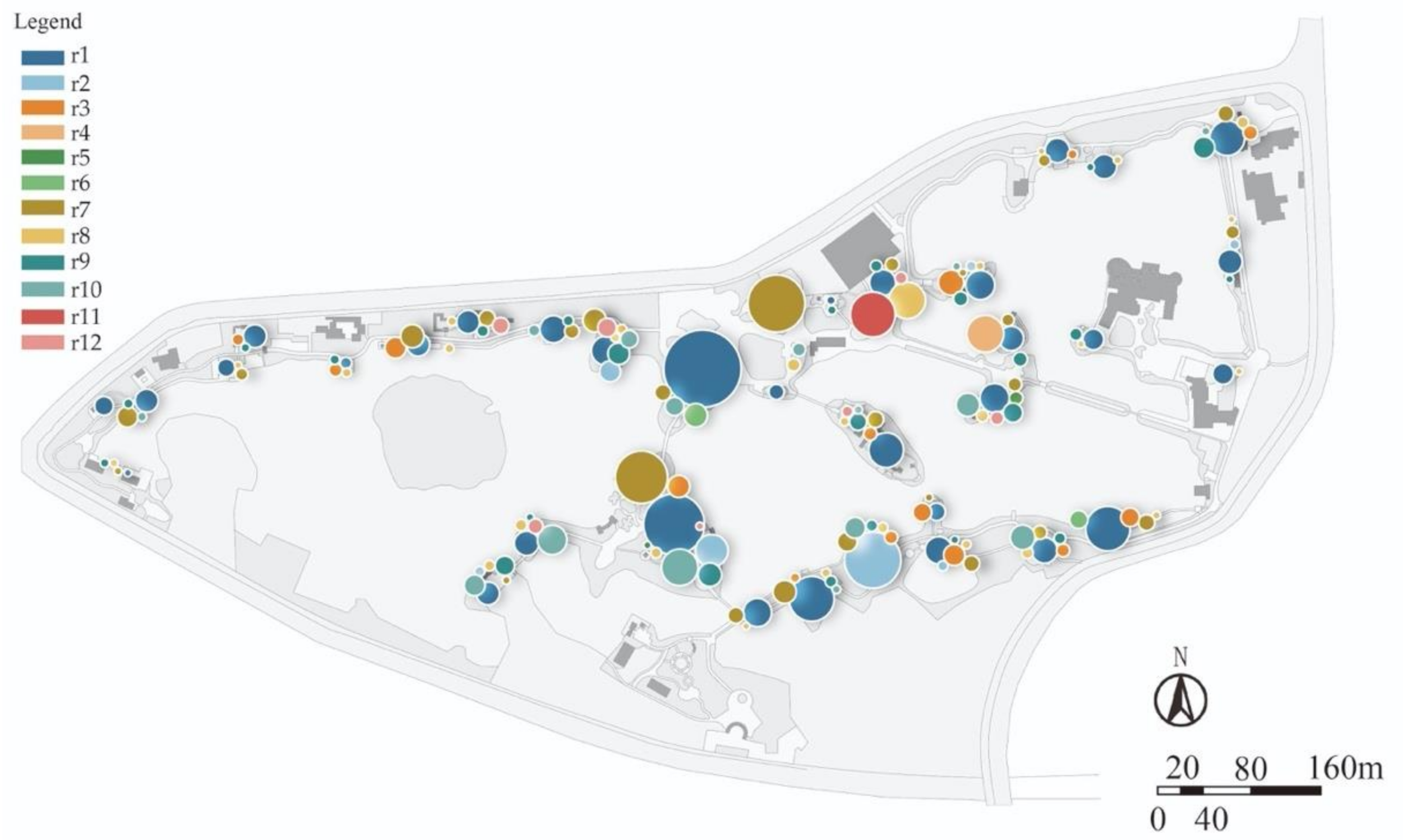
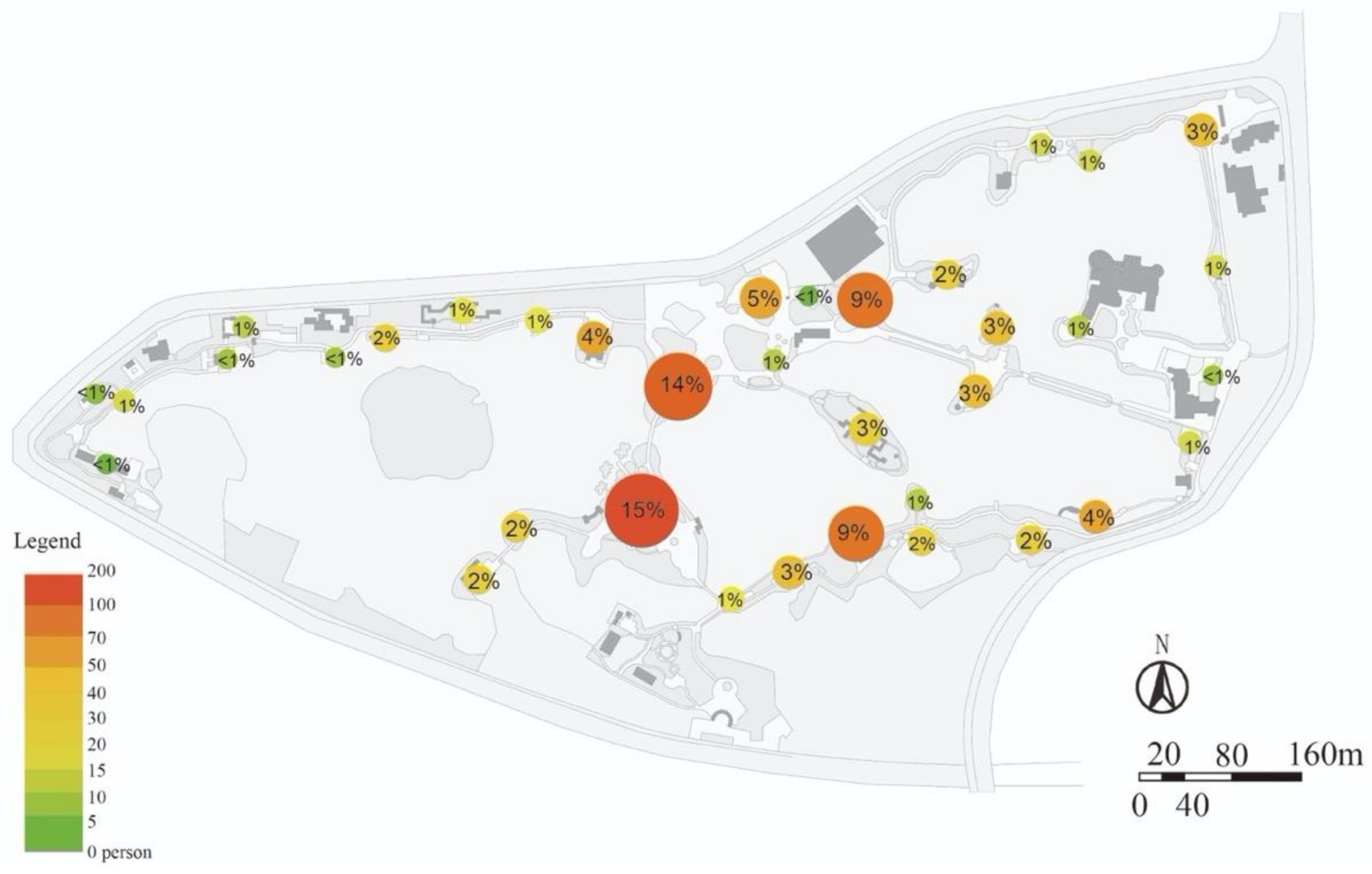
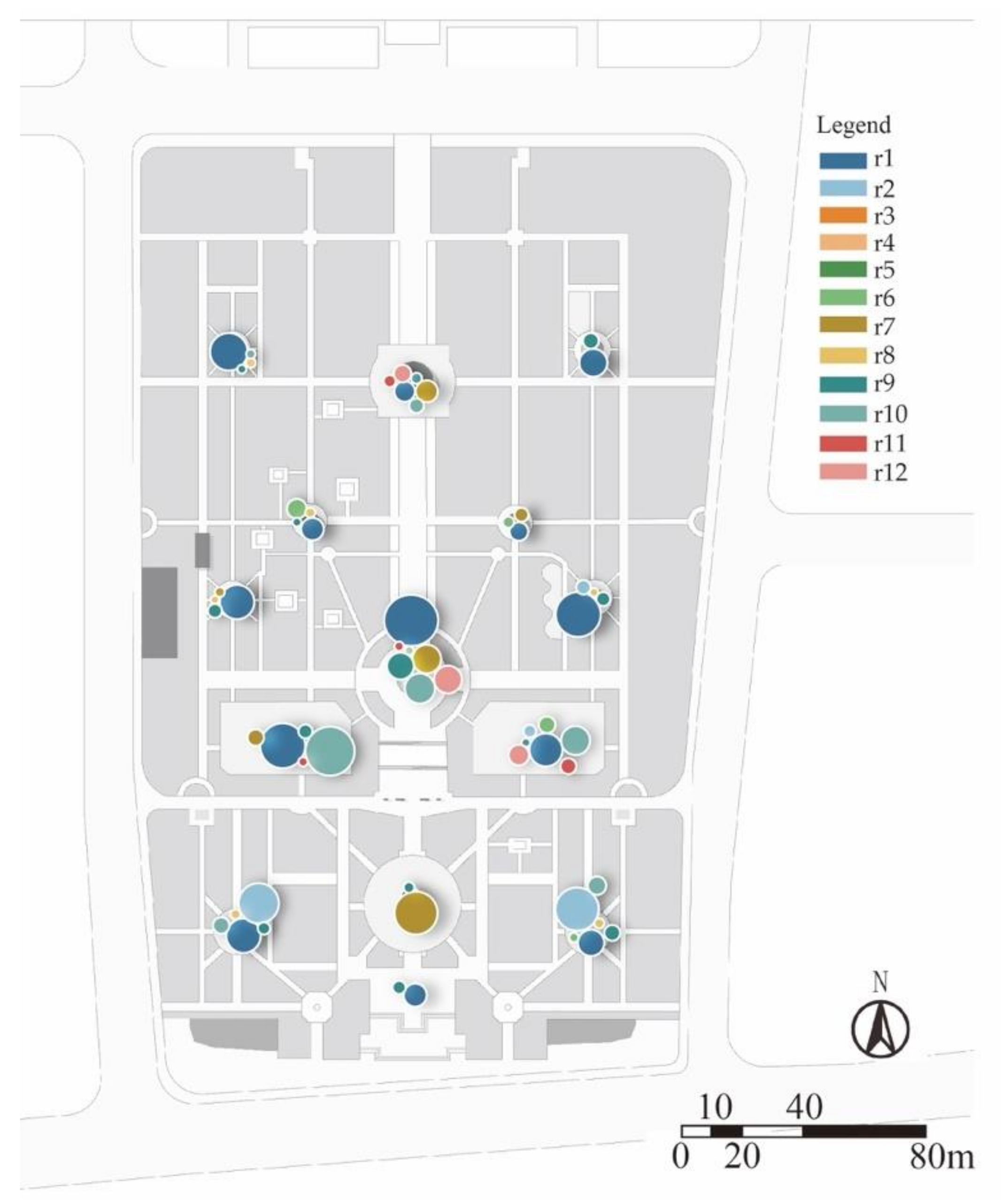
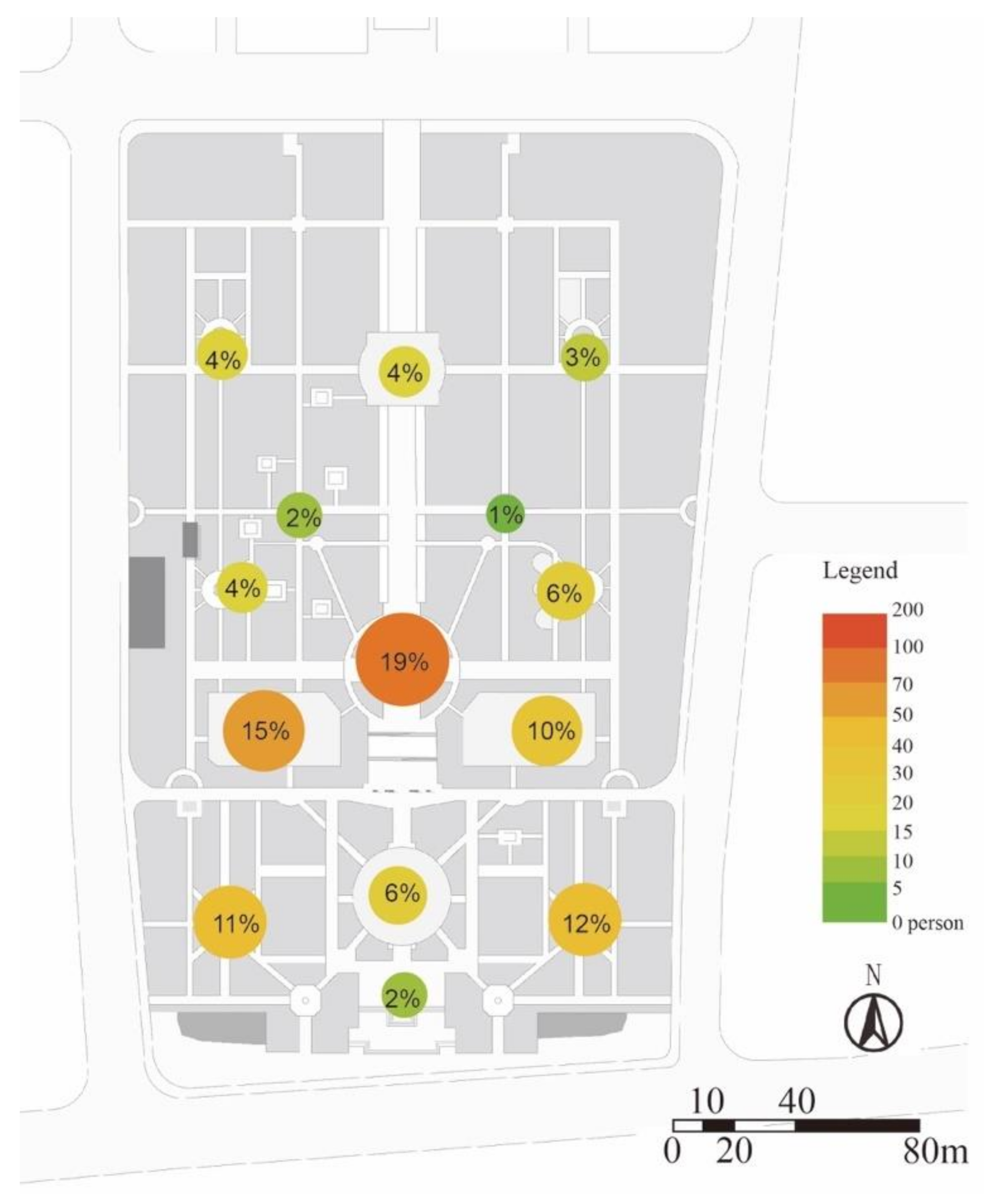
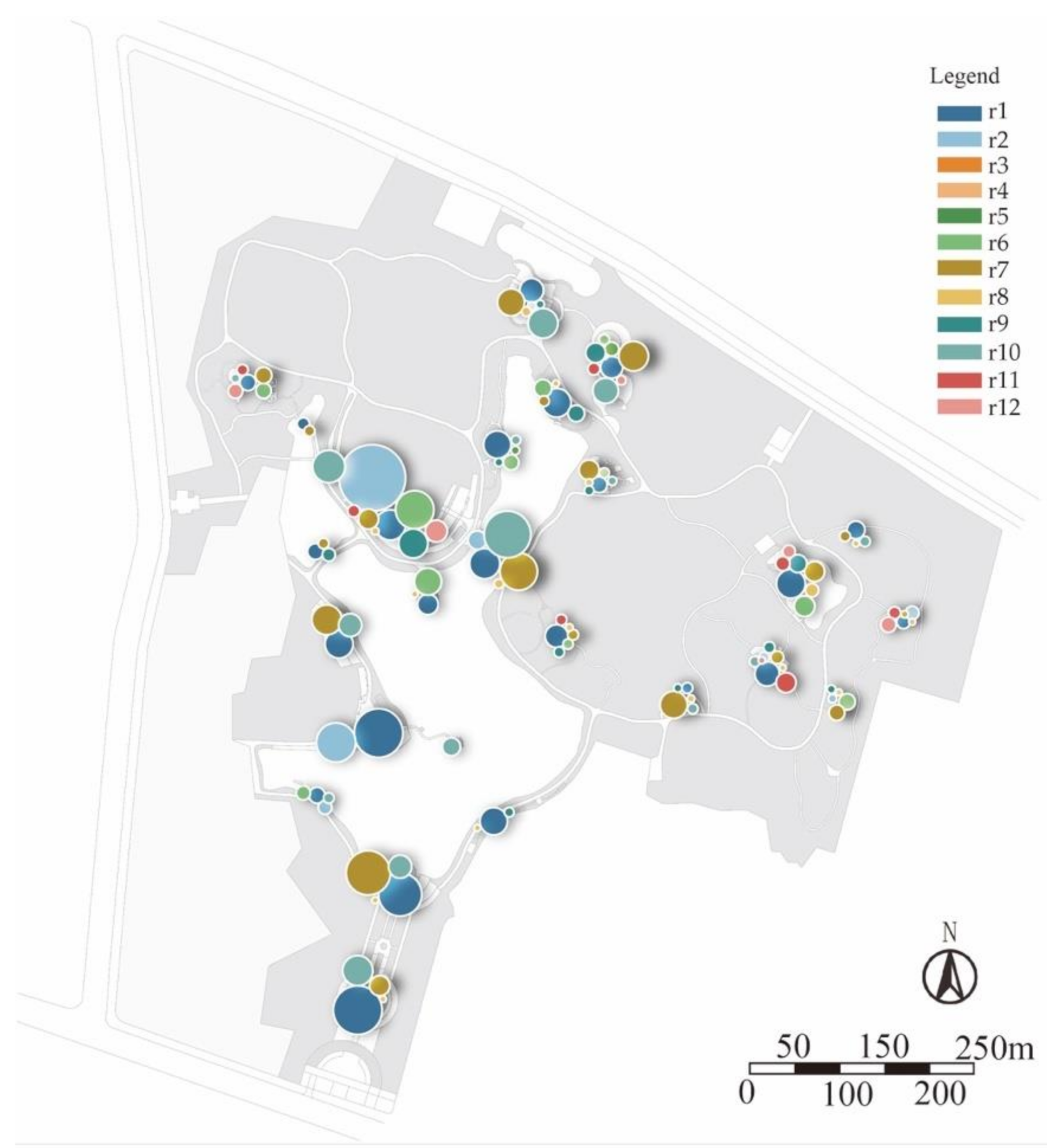
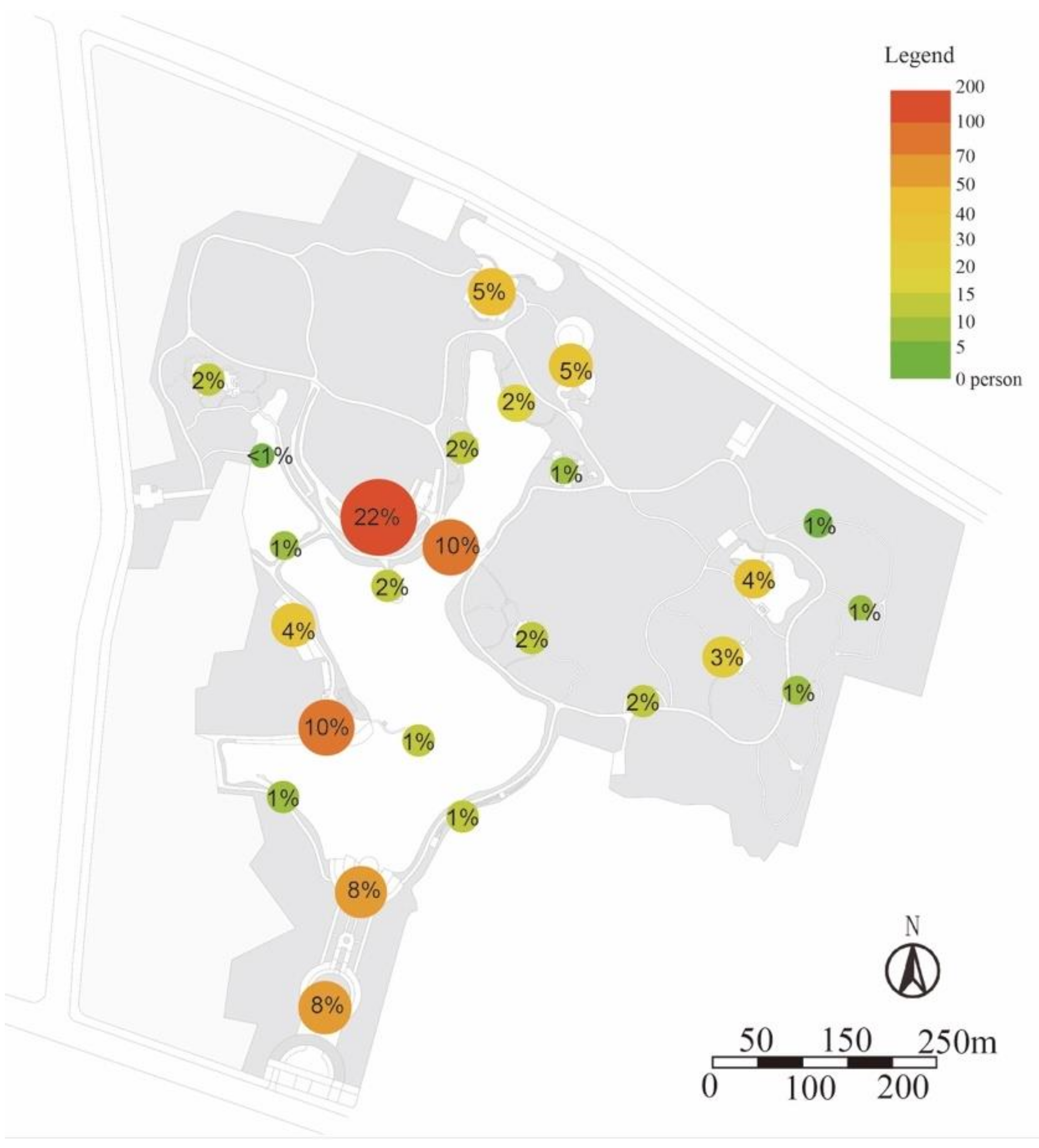
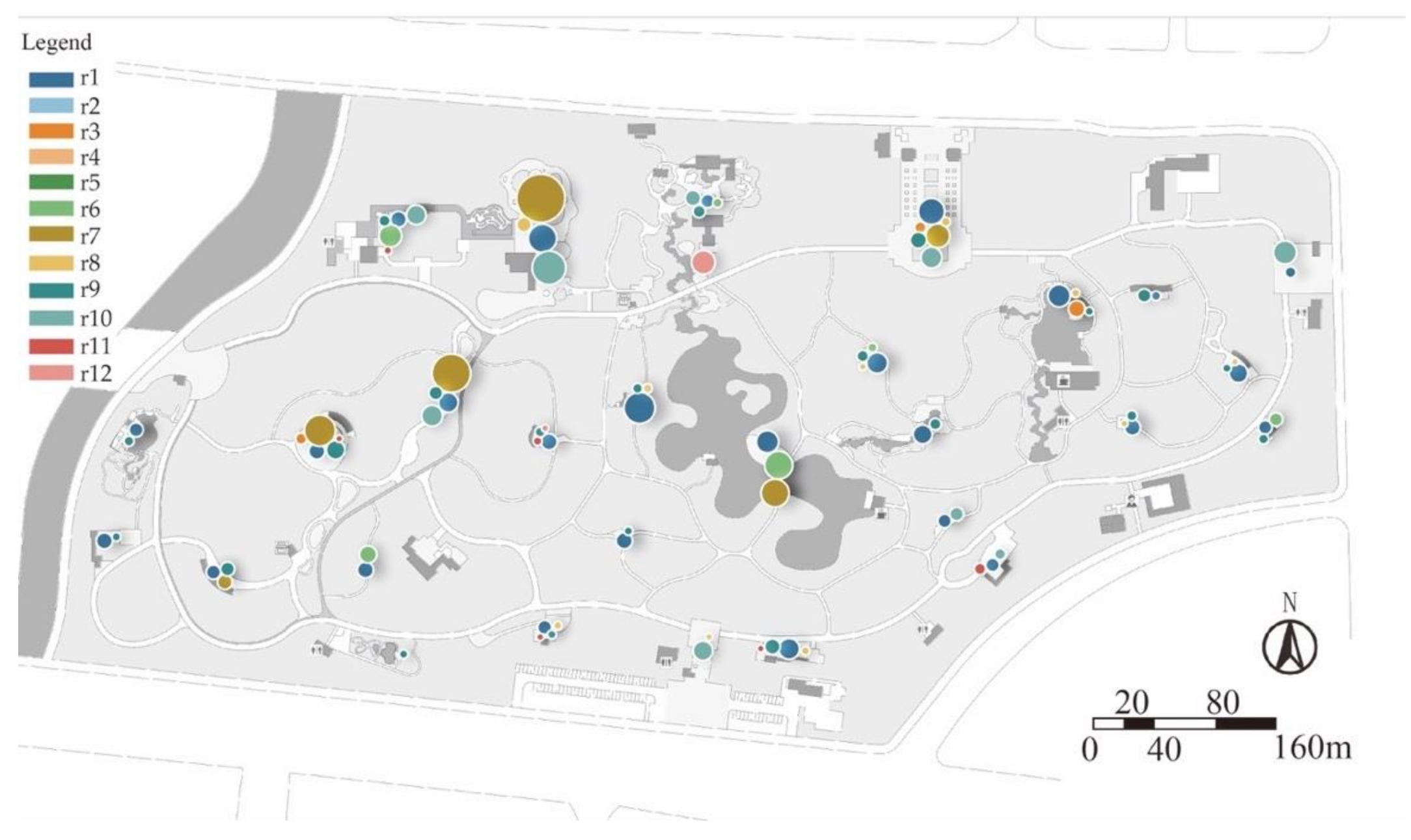
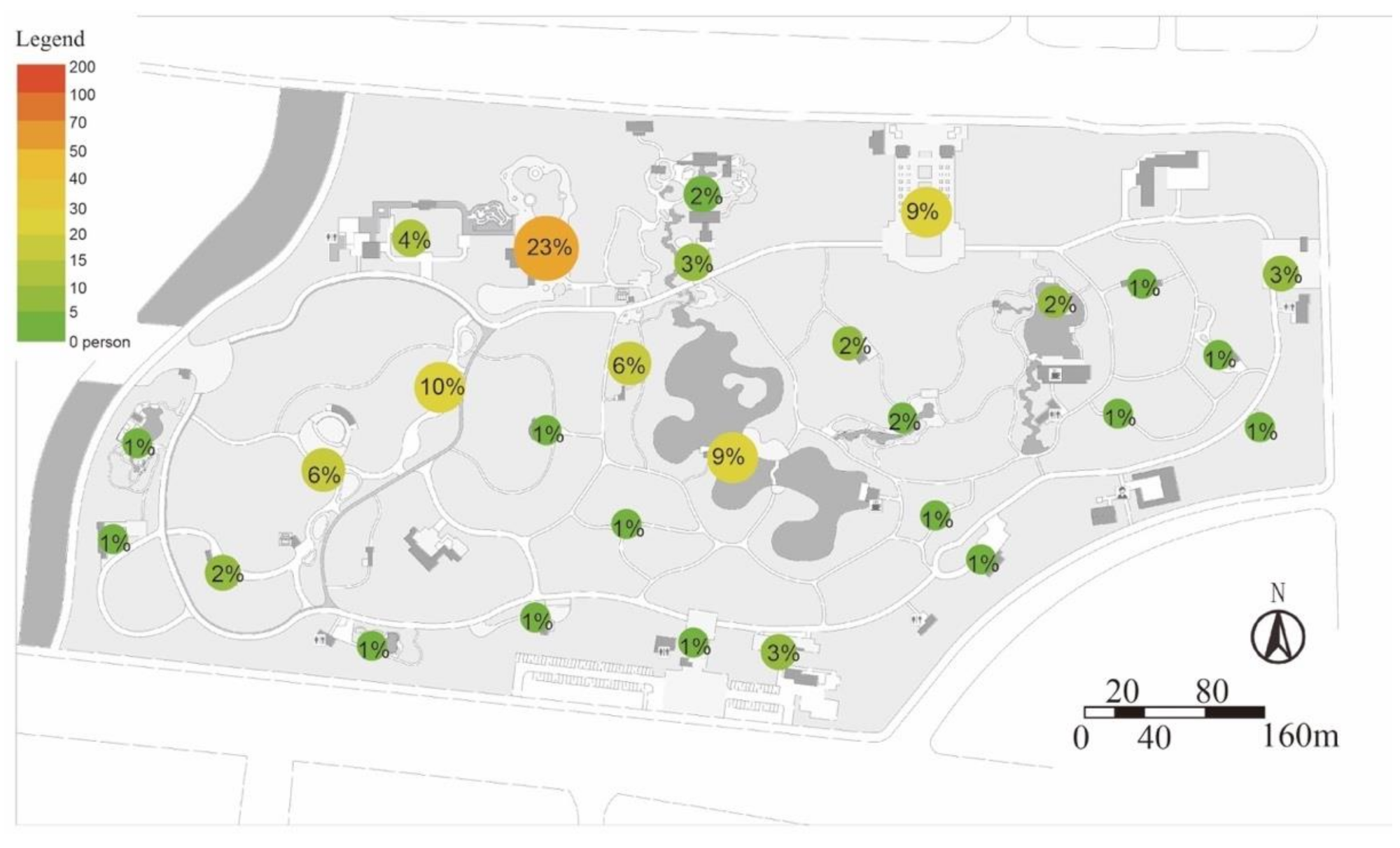
Appendix D
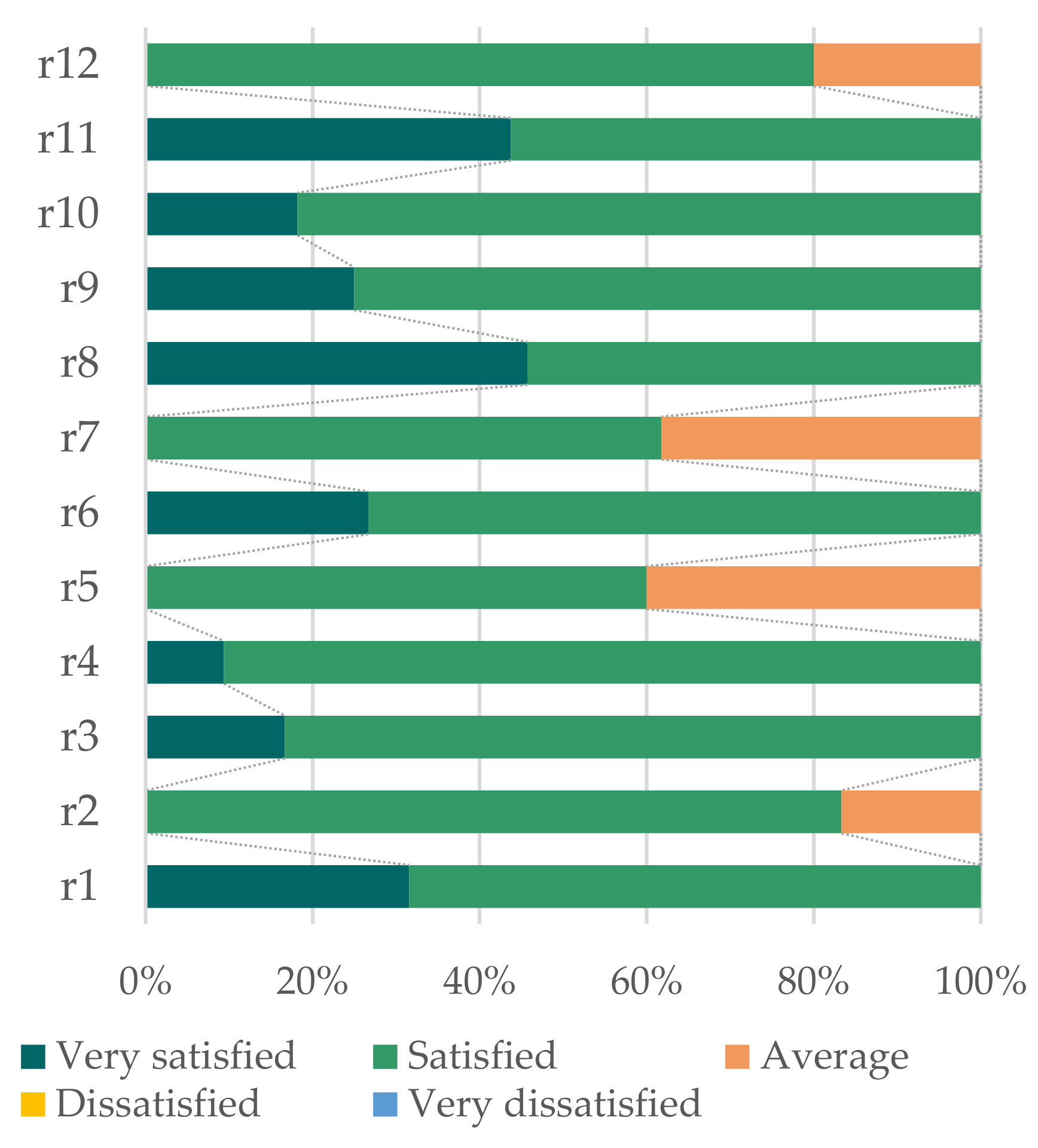
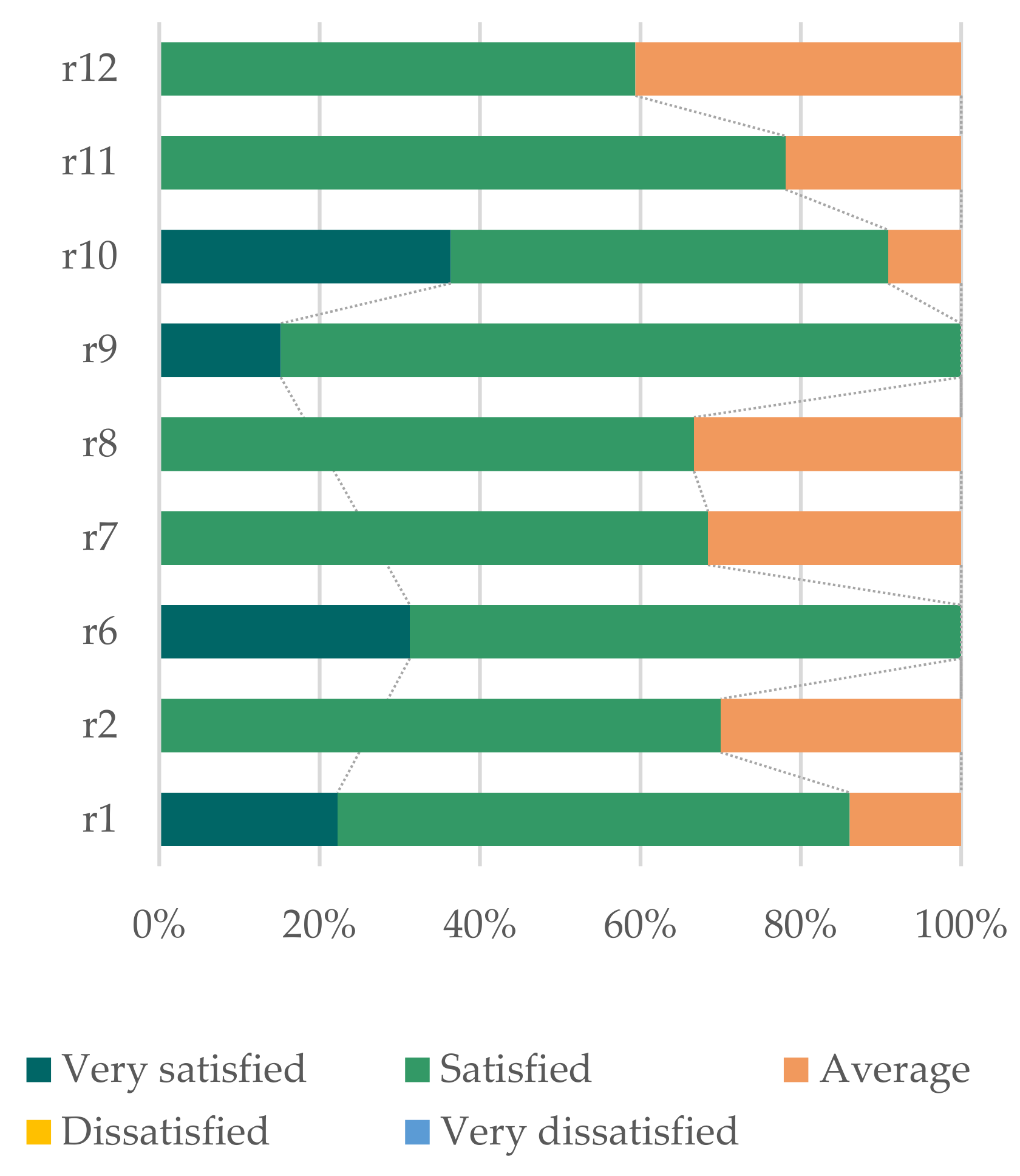
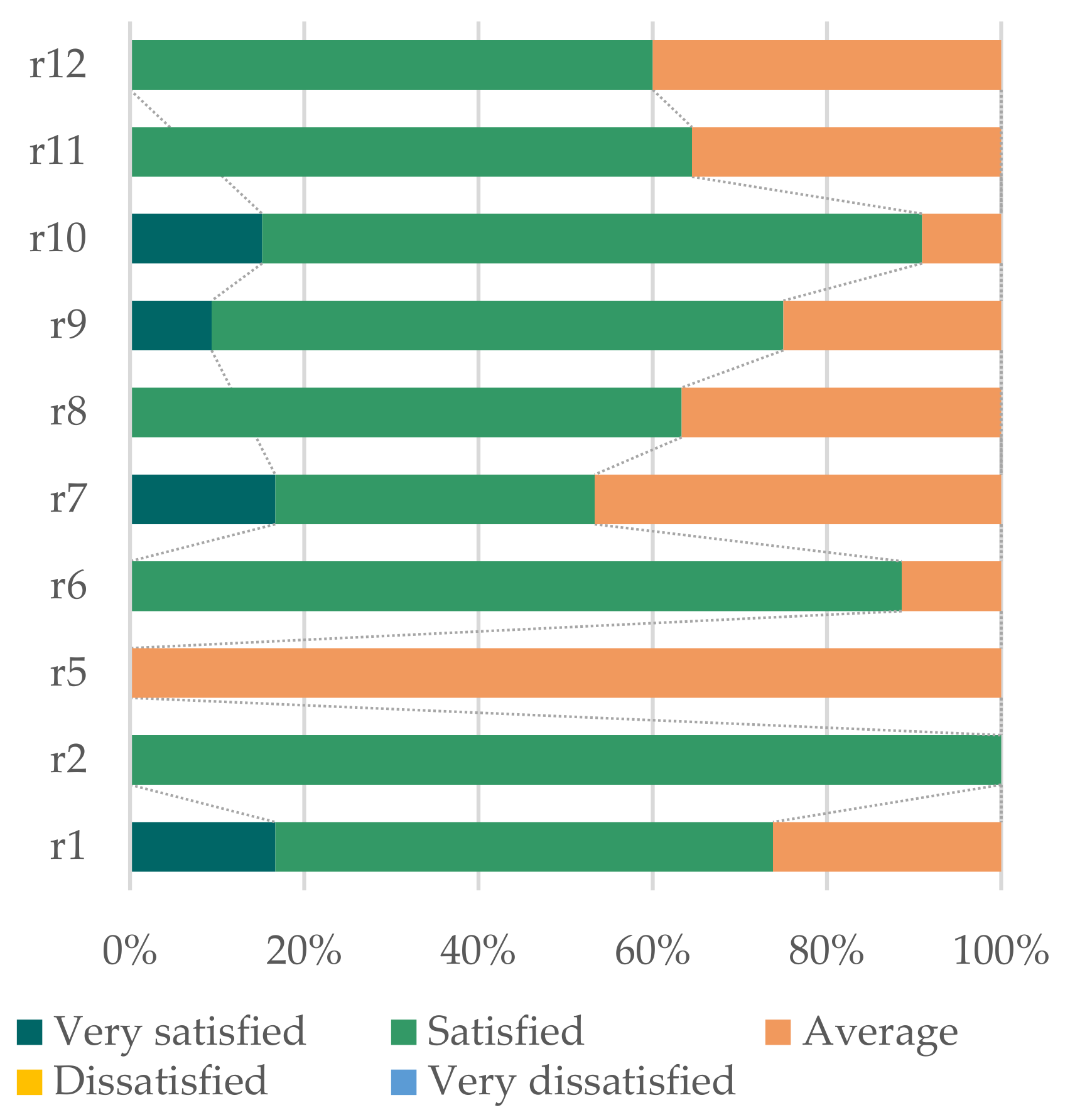
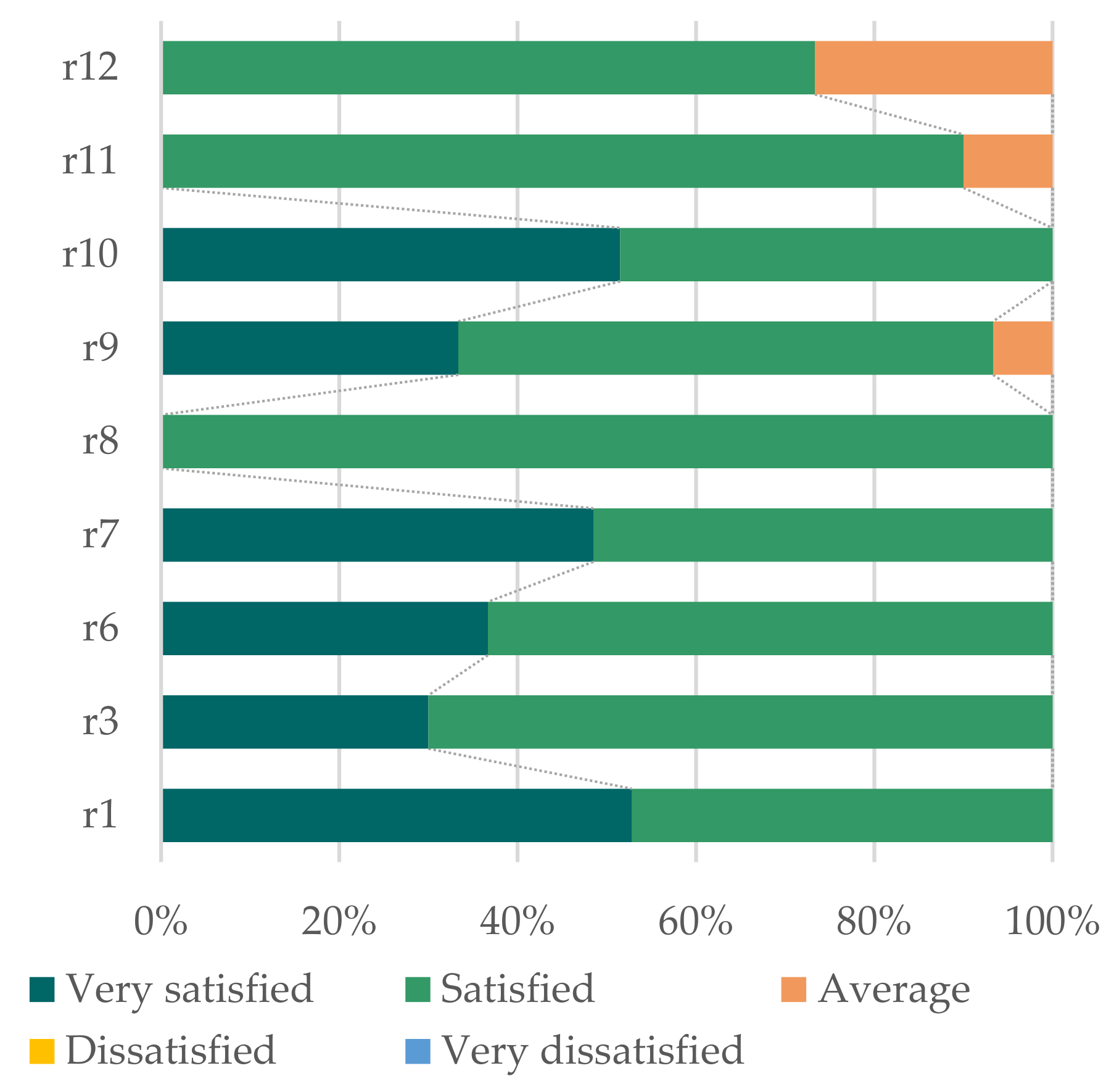
References
- Annerstedt, M.; Nielsen, B.; Maaruthaveeran, S.; Konijnendijk, C. Benefits of urban parks: A systematic review. IFPRA World 2012, 6, 10–12. [Google Scholar]
- Bolund, P.; Hunhammar, S. Ecosystem services in urban areas. Ecol. Econ. 1999, 29, 293–301. [Google Scholar] [CrossRef]
- Bedimo-Rung, A.L.; Mowen, A.J.; Cohen, D.A. The significance of parks to physical activity and public health: A conceptual model. Am. J. Prev. Med. 2005, 28, 159–168. [Google Scholar] [CrossRef] [PubMed]
- Bertram, C.; Meyerhoff, J.; Rehdanz, K.; Wüstemann, H. Differences in the recreational value of urban parks between weekdays and weekends: A discrete choice analysis. Landsc. Urban Plan. 2017, 159, 5–14. [Google Scholar] [CrossRef]
- Fischer, L.K.; Honold, J.; Botzat, A.; Brinkmeyer, D.; Cvejić, R.; Delshammar, T.; Elands, B.; Haase, D.; Kabisch, N.; Karle, S.J. Recreational ecosystem services in European cities: Sociocultural and geographical contexts matter for park use. Ecosyst. Serv. 2018, 31, 455–467. [Google Scholar] [CrossRef]
- Brown, G.; Schebella, M.F.; Weber, D. Using participatory GIS to measure physical activity and urban park benefits. Landsc. Urban Plan. 2014, 121, 34–44. [Google Scholar] [CrossRef]
- Rogerson, M.; Gladwell, V.F.; Gallagher, D.J.; Barton, J.L. Influences of green outdoors versus indoors environmental settings on psychological and social outcomes of controlled exercise. Int. J. Environ. Res. Public Health 2016, 13, 363. [Google Scholar] [CrossRef]
- Sugiyama, T.; Carver, A.; Koohsari, M.J.; Veitch, J. Advantages of public green spaces in enhancing population health. Landsc. Urban Plan. 2018, 178, 12–17. [Google Scholar] [CrossRef]
- Liu, H.; Li, F.; Li, J.; Zhang, Y. The relationships between urban parks, residents’ physical activity, and mental health benefits: A case study from Beijing, China. J. Environ. Manag. 2017, 190, 223–230. [Google Scholar] [CrossRef]
- Saffuan, R.; Ariffin, J.; Amin, Z. Planning park for liveable cities: Green technology design practice for Tasik Biru Kundang, Kuang, Selangor, Malaysia. Procedia Soc. Behav. Sci. 2012, 35, 705–712. [Google Scholar] [CrossRef]
- Waitt, G.; Knobel, H. Embodied geographies of liveability and urban parks. Urban Stud. 2018, 55, 3151–3167. [Google Scholar] [CrossRef]
- Lee, G.; Hong, I. Measuring spatial accessibility in the context of spatial disparity between demand and supply of urban park service. Landsc. Urban Plan. 2013, 119, 85–90. [Google Scholar] [CrossRef]
- Liu, S. Urban Park Planning on Spatial Disparity between Demand and Supply of Park Service. In Proceedings of the 2015 3rd International Conference on Advances in Energy and Environmental Science, Zhuhai, China, 25–26 July 2015. [Google Scholar] [CrossRef]
- Liu, H.; Remme, R.P.; Hamel, P.; Nong, H.; Ren, H. Supply and demand assessment of urban recreation service and its implication for greenspace planning: A case study on Guangzhou. Landsc. Urban Plan. 2020, 203, 103898. [Google Scholar] [CrossRef]
- Ministry of Housing and Urban-Rural Development of the People’s Republic of China. Series Standards for National Garden Cities. Available online: http://www.mohurd.gov.cn/wjfb/201611/t20161104_229393.html (accessed on 16 October 2020).
- Hillsdon, M.; Panter, J.; Foster, C.; Jones, A. The relationship between access and quality of urban green space with population physical activity. Public Health 2006, 120, 1127–1132. [Google Scholar] [CrossRef]
- Francis, J.; Wood, L.J.; Knuiman, M.; Giles-Corti, B. Quality or quantity? Exploring the relationship between Public Open Space attributes and mental health in Perth, Western Australia. Soc. Sci. Med. 2012, 74, 1570–1577. [Google Scholar] [CrossRef]
- Sugiyama, T.; Gunn, L.D.; Christian, H.; Francis, J.; Foster, S.; Hooper, P.; Owen, N.; Giles-Corti, B. Quality of public open spaces and recreational walking. Am. J. Public Health 2015, 105, 2490–2495. [Google Scholar] [CrossRef]
- Mullenbach, L.E.; Mowen, A.J.; Baker, B.L. Assessing the relationship between a composite score of urban park quality and health. Prev. Chronic Dis. 2018, 15, E136. [Google Scholar] [CrossRef]
- Zhang, Y.; Van den Berg, A.E.; Van Dijk, T.; Weitkamp, G. Quality over quantity: Contribution of urban green space to neighborhood satisfaction. Int. J. Environ. Res. Public Health 2017, 14, 535. [Google Scholar] [CrossRef]
- Costigan, S.A.; Veitch, J.; Crawford, D.; Carver, A.; Timperio, A. A cross-sectional investigation of the importance of park features for promoting regular physical activity in parks. Int. J. Environ. Res. Public Health 2017, 14, 1335. [Google Scholar] [CrossRef]
- Veitch, J.; Salmon, J.; Deforche, B.; Ghekiere, A.; Van Cauwenberg, J.; Bangay, S.; Timperio, A. Park attributes that encourage park visitation among adolescents: A conjoint analysis. Landsc. Urban Plan. 2017, 161, 52–58. [Google Scholar] [CrossRef]
- Cohen, D.A.; Setodji, C.; Evenson, K.R.; Ward, P.; Lapham, S.; Hillier, A.; McKenzie, T.L. How much observation is enough? Refining the administration of SOPARC. J. Phys. Act. Health 2011, 8, 1117–1123. [Google Scholar] [CrossRef]
- Bahriny, F.; Bell, S. Patterns of urban park use and their relationship to factors of quality: A case study of Tehran, Iran. Sustainability 2020, 12, 1560. [Google Scholar] [CrossRef]
- Cohen, D.A.; Han, B.; Nagel, C.J.; Harnik, P.; McKenzie, T.L.; Evenson, K.R.; Marsh, T.; Williamson, S.; Vaughan, C.; Katta, S. The first national study of neighborhood parks: Implications for physical activity. Am. J. Prev. Med. 2016, 51, 419–426. [Google Scholar] [CrossRef] [PubMed]
- Yang, B.; Li, S.; Binder, C. A research frontier in landscape architecture: Landscape performance and assessment of social benefits. Landsc. Res. 2016, 41, 314–329. [Google Scholar] [CrossRef]
- Xu, M.; Xin, J.; Su, S.; Weng, M.; Cai, Z. Social inequalities of park accessibility in Shenzhen, China: The role of park quality, transport modes, and hierarchical socioeconomic characteristics. J. Transp. Geogr. 2017, 62, 38–50. [Google Scholar] [CrossRef]
- Zhai, Y.; Wu, H.; Fan, H.; Wang, D. Using mobile signaling data to exam urban park service radius in Shanghai: Methods and limitations. Comput. Environ. Urban Syst. 2018, 71, 27–40. [Google Scholar] [CrossRef]
- Schipperijn, J.; Ekholm, O.; Stigsdotter, U.K.; Toftager, M.; Bentsen, P.; Kamper-Jørgensen, F.; Randrup, T.B. Factors influencing the use of green space: Results from a Danish national representative survey. Landsc. Urban Plan. 2010, 95, 130–137. [Google Scholar] [CrossRef]
- Schipperijn, J.; Stigsdotter, U.K.; Randrup, T.B.; Troelsen, J. Influences on the use of urban green space: A case study in Odense, Denmark. Urban For. Urban Green. 2010, 9, 25–32. [Google Scholar] [CrossRef]
- Golicnik, B.; Ward Thompson, C. Emerging relationships between design and use of urban park spaces. Landsc. Urban Plan. 2010, 94, 38–53. [Google Scholar] [CrossRef]
- Holman, C.; Donovan, R.; Corti, B. Factors influencing the use of physical activity facilities: Results from qualitative research. Health Promot. J. Austr. 1996, 6, 16–21. [Google Scholar]
- Perloff, H.S.; Wingo, L. Urban growth and the planning of outdoor recreation. In Land and Leisure: Concepts and Methods in Outdoor Recreation, 2nd ed.; Doren, C.S., Van Priddle, G.B., Lewis, J.E., Eds.; Routledge: London, UK, 2019; pp. 36–53. [Google Scholar]
- Francis, M. Urban Open Space: Designing for User Needs; Island Press: Washington, DC, USA; Covelo, CA, USA; London, UK, 2003; p. 1. [Google Scholar]
- Kaczynski, A.T.; Havitz, M.E. Examining the relationship between proximal park features and residents’ physical activity in neighborhood parks. J. Park Recreat. Adm. 2009, 27, 42–58. [Google Scholar]
- Joseph, R.P.; Maddock, J.E. Observational park-based physical activity studies: A systematic review of the literature. Prev. Med. 2016, 89, 257–277. [Google Scholar] [CrossRef] [PubMed]
- Rahnema, S.; Sedaghathoor, S.; Allahyari, M.S.; Damalas, C.A.; Bilali, H.E. Preferences and emotion perceptions of ornamental plant species for green space designing among urban park users in Iran. Urban For. Urban Green. 2019, 39, 98–108. [Google Scholar] [CrossRef]
- Subramanian, D.; Jana, A. Assessing urban recreational open spaces for the elderly: A case of three Indian cities. Urban For. Urban Green. 2018, 35, 115–128. [Google Scholar] [CrossRef]
- Marcus, C.C.; Francis, C. People Places: Design Guidelines for Urban Open Space, 2nd ed.; Van Nostrand Reinhold: New York, NY, USA, 1997. [Google Scholar]
- Yu, B.; Che, S.; Xie, C.; Tian, S. Understanding Shanghai residents’ perception of leisure impact and experience satisfaction of urban community parks: An integrated and IPA method. Sustainability 2018, 10, 1067. [Google Scholar] [CrossRef]
- Karuppannan, S.; Sivam, A. Comparative analysis of utilisation of open space at neighbourhood level in three Asian cities: Singapore, Delhi and Kuala Lumpur. Urban Des. Int. 2013, 18, 145–164. [Google Scholar] [CrossRef]
- Kaczynski, A.T.; Henderson, K.A. Environmental correlates of physical activity: A review of evidence about parks and recreation. Leis. Sci. 2007, 29, 315–354. [Google Scholar] [CrossRef]
- Akpinar, A. How is quality of urban green spaces associated with physical activity and health? Urban For. Urban Green. 2016, 16, 76–83. [Google Scholar] [CrossRef]
- McCormack, G.R.; Rock, M.; Toohey, A.M.; Hignell, D. Characteristics of urban parks associated with park use and physical activity: A review of qualitative research. Health Place 2010, 16, 712–726. [Google Scholar] [CrossRef]
- Zhang, W.; Yang, J.; Ma, L.; Huang, C. Factors affecting the use of urban green spaces for physical activities: Views of young urban residents in Beijing. Urban For. Urban Green. 2015, 14, 851–857. [Google Scholar] [CrossRef]
- MacKay, K.J.; Crompton, J.L. Measuring the quality of recreation services. J. Park Recreat. Adm. 1990, 8, 47–56. [Google Scholar]
- Chen, W.Y.; Jim, C.Y. Cost–benefit analysis of the leisure value of urban greening in the new Chinese city of Zhuhai. Cities 2008, 25, 298–309. [Google Scholar] [CrossRef]
- Chen, C.; Luo, W.; Li, H.; Zhang, D.; Kang, N.; Yang, X.; Xia, Y. Impact of perception of green space for health promotion on willingness to use parks and actual use among young urban residents. Int. J. Environ. Res. Public Health 2020, 17, 5560. [Google Scholar] [CrossRef]
- Cohen, D.A.; Marsh, T.; Williamson, S.; Derose, K.P.; Martinez, H.; Setodji, C.; McKenzie, T.L. Parks and physical activity: Why are some parks used more than others? Prev. Med. 2010, 50, S9–S12. [Google Scholar] [CrossRef]
- Baran, P.K.; Smith, W.R.; Moore, R.C.; Floyd, M.F.; Bocarro, J.N.; Cosco, N.G.; Danninger, T.M. Park use among youth and adults: Examination of individual, social, and urban form factors. Environ. Behav. 2014, 46, 768–800. [Google Scholar] [CrossRef]
- Kulczyk, S.; Woźniak, E.; Derek, M. Landscape, facilities and visitors: An integrated model of recreational ecosystem services. Ecosyst. Serv. 2018, 31, 491–501. [Google Scholar] [CrossRef]
- Yessoufou, K.; Sithole, M.; Elansary, H.O. Effects of urban green spaces on human perceived health improvements: Provision of green spaces is not enough but how people use them matters. PLoS ONE 2020, 15, e0239314. [Google Scholar] [CrossRef]
- Ministry of Housing and Urban-Rural Development of the People’s Republic of China. Code for the Design of Public Park (GB 51192-2016); China Building Industry Publishing: Beijing, China, 2016; p. 8.
- Guangzhou Statistics Bureau. Population Size and Distribution of Guangzhou in 2019. Available online: http://tjj.gz.gov.cn/tjgb/qtgb/content/post_5729556.html (accessed on 28 February 2021).
- Guangzhou Statistical Yearbook. Available online: http://112.94.72.17/portal/queryInfo/statisticsYearbook/index (accessed on 28 February 2021).
- Wang, X.; Wu, C. An observational study of park attributes and physical activity in neighborhood parks of Shanghai, China. Int. J. Environ. Res. Public Health 2020, 17, 2080. [Google Scholar] [CrossRef]
- Tu, H.; Liao, X.; Schuller, K.; Cook, A.; Fan, S.; Lan, G.; Yuan, Z.; Moore, J.B.; Maddock, J.E. Insights from an observational assessment of park-based physical activity in Nanchang, China. Prev. Med. Rep. 2015, 2, 930–934. [Google Scholar] [CrossRef]
- Chow, B.; McKenzie, T.; Sit, C. Public parks in Hong Kong: Characteristics of physical activity areas and their users. Int. J. Environ. Res. Public Health 2016, 13, 639. [Google Scholar] [CrossRef]
- Zhang, H.; Chen, B.; Sun, Z.; Bao, Z. Landscape perception and recreation needs in urban green space in Fuyang, Hangzhou, China. Urban For. Urban Green. 2013, 12, 44–52. [Google Scholar] [CrossRef]
- Sugiyama, T.; Francis, J.; Middleton, N.J.; Owen, N.; Giles-Corti, B. Associations between recreational walking and attractiveness, size, and proximity of neighborhood open spaces. Am. J. Public Health 2010, 100, 1752–1757. [Google Scholar] [CrossRef] [PubMed]
- Rey Gozalo, G.; Barrigón Morillas, J.M.; Montes González, D. Perceptions and use of urban green spaces on the basis of size. Urban For. Urban Green. 2019, 46, 126470. [Google Scholar] [CrossRef]
- Zhang, S.; Zhou, W. Recreational visits to urban parks and factors affecting park visits: Evidence from geotagged social media data. Landsc. Urban Plan. 2018, 180, 27–35. [Google Scholar] [CrossRef]
- Kaczynski, A.T.; Potwarka, L.R.; Saelens, B.E. Association of park size, distance, and features with physical activity in neighborhood parks. Am. J. Public Health 2008, 98, 1451–1456. [Google Scholar] [CrossRef] [PubMed]
- China Statistical Yearbook. Available online: http://www.stats.gov.cn/tjsj/ndsj/2020/indexch.htm (accessed on 28 February 2021).
- Su, M.; Tan, Y.-Y.; Liu, Q.-M.; Ren, Y.-J.; Kawachi, I.; Li, L.-M.; Lv, J. Association between perceived urban built environment attributes and leisure-time physical activity among adults in Hangzhou, China. Prev. Med. 2014, 66, 60–64. [Google Scholar] [CrossRef]
- Shan, X.-Z. Socio-demographic variation in motives for visiting urban green spaces in a large Chinese city. Habitat Int. 2014, 41, 114–120. [Google Scholar] [CrossRef]
- Park, K.; Ewing, R. The usability of unmanned aerial vehicles (UAVs) for measuring park-based physical activity. Landsc. Urban Plan. 2017, 167, 157–164. [Google Scholar] [CrossRef]
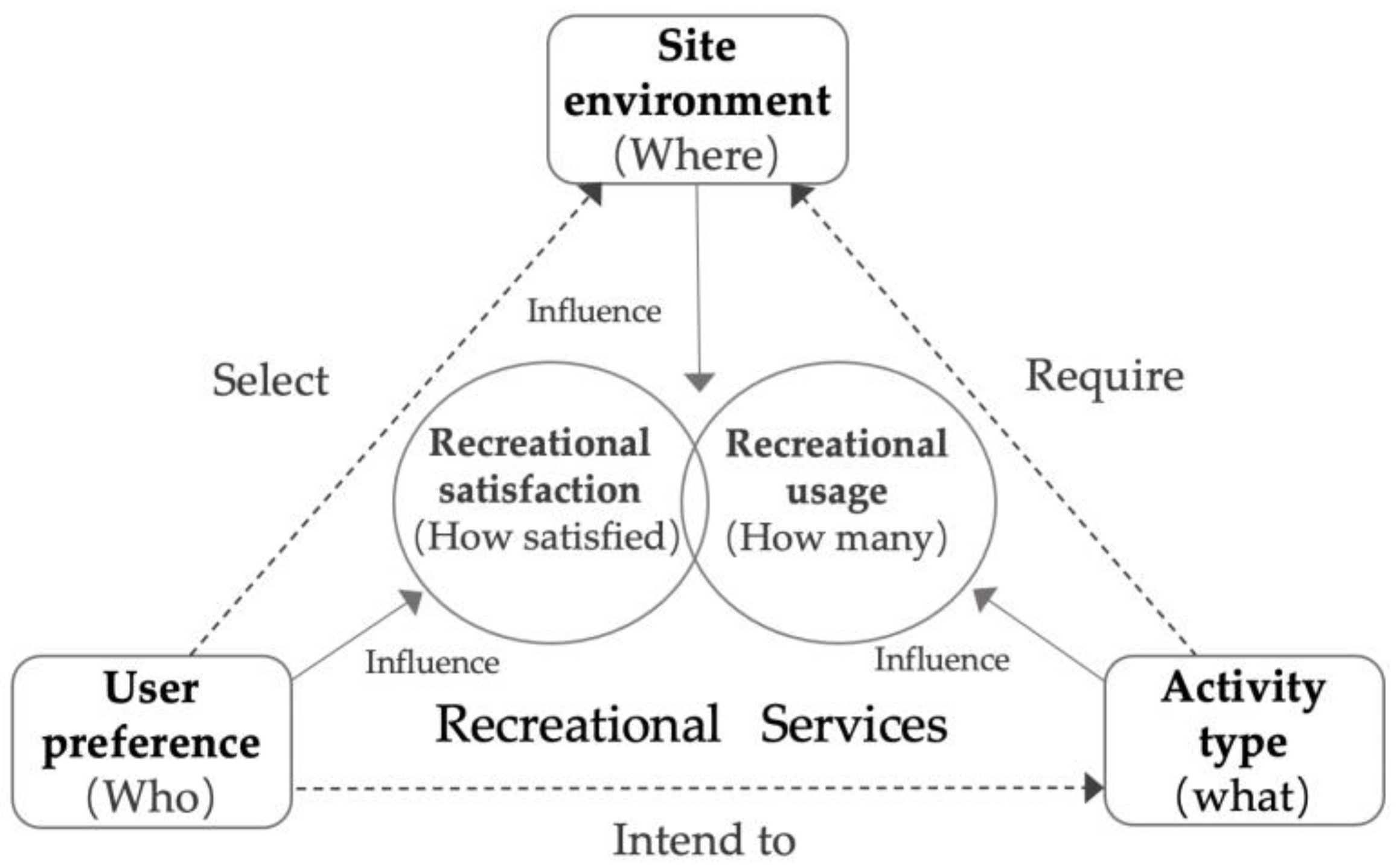
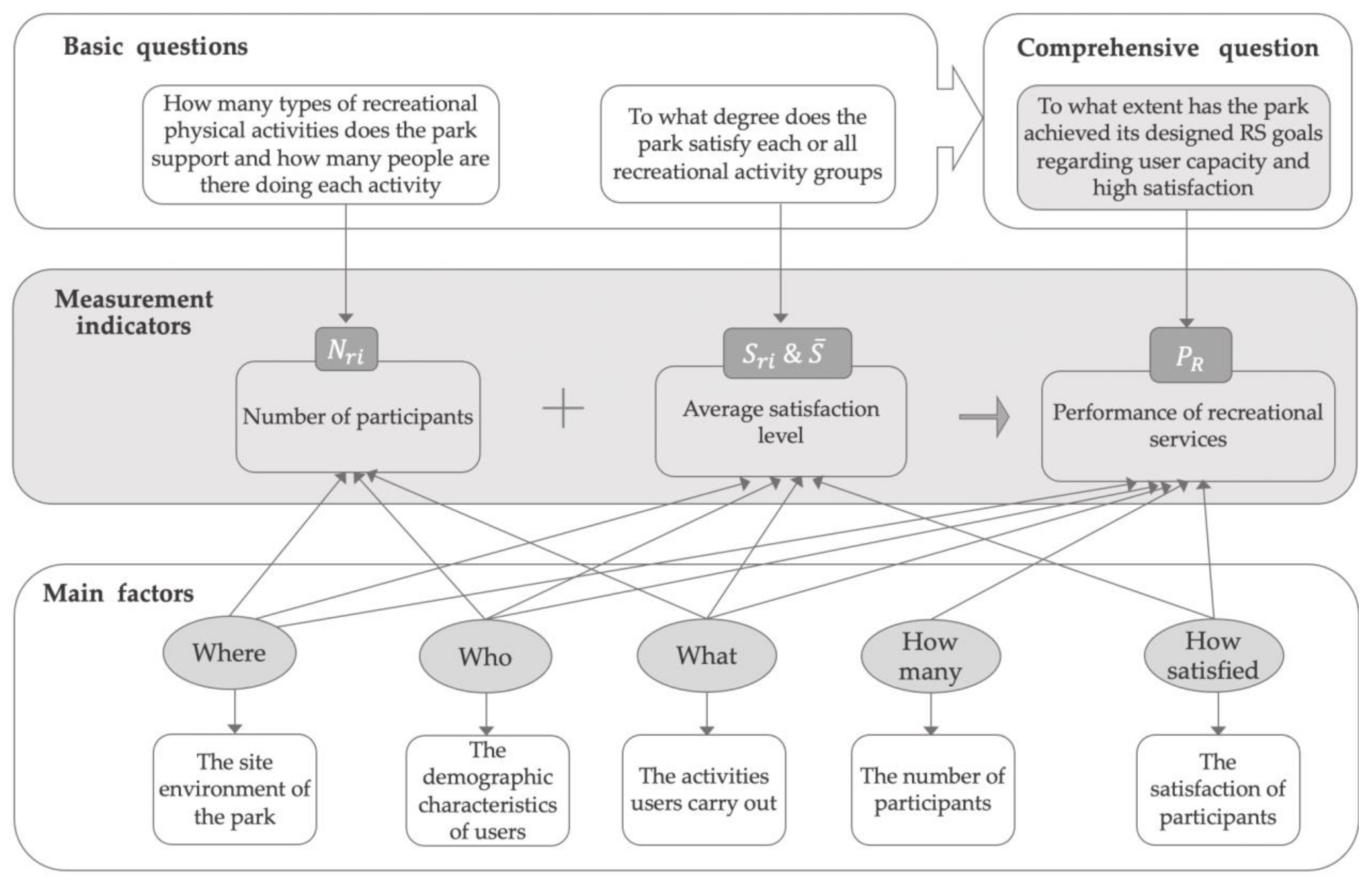
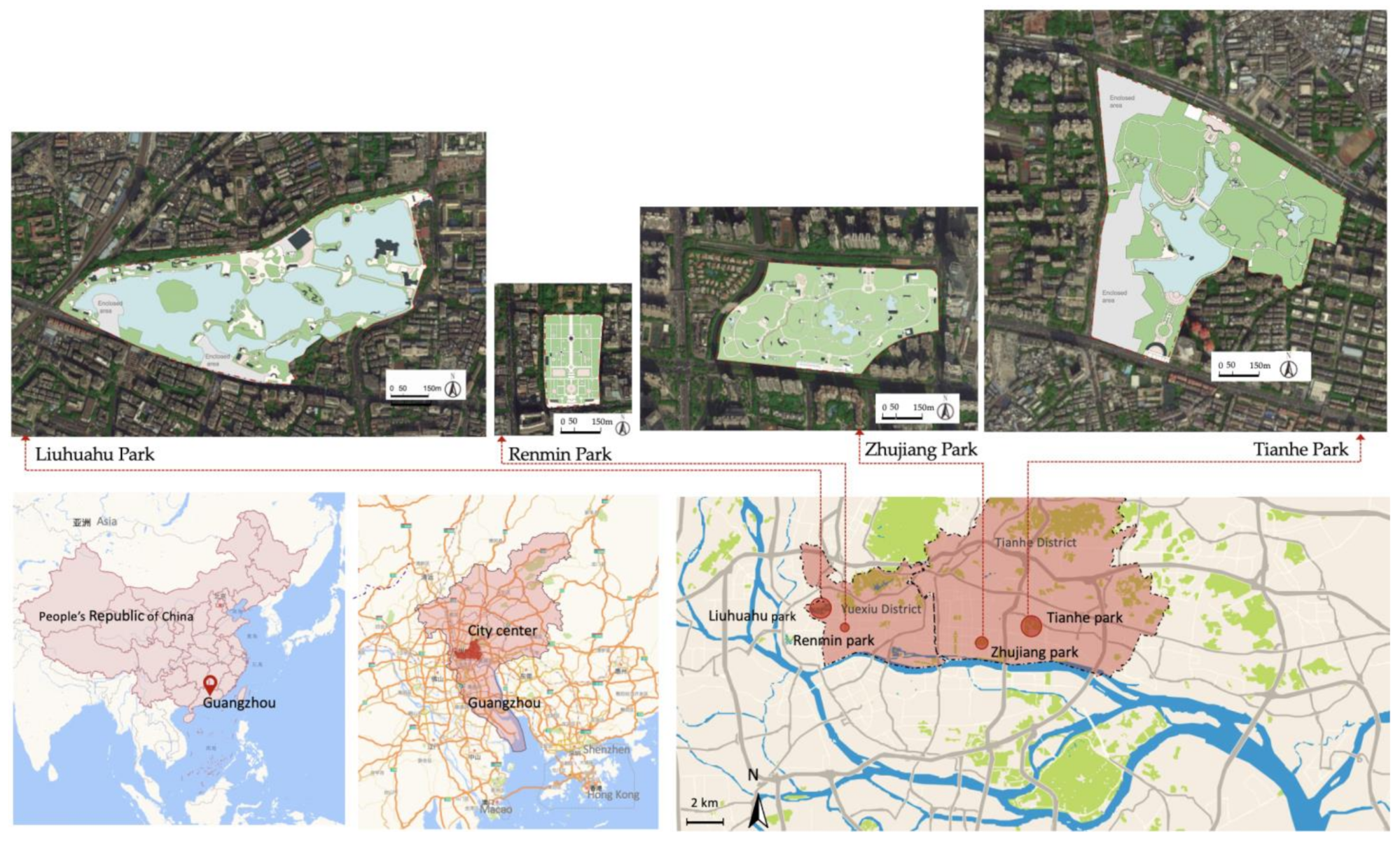
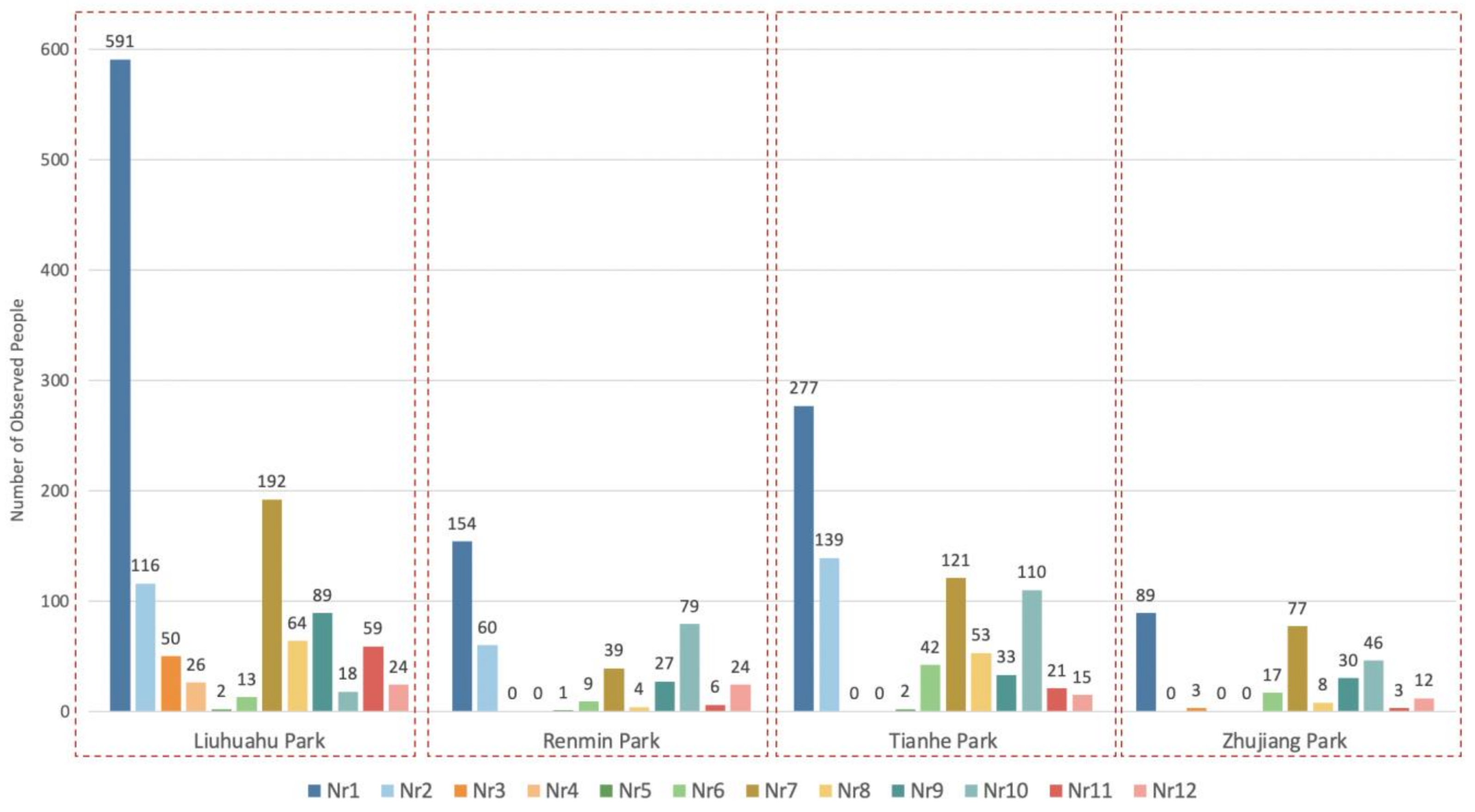
| Item | 1949 | 1957 | 1962 | 1979 | 1989 | 1999 | 2001 | 2005 | 2010 | 2015 | 2016 | 2017 | 2018 | 2019 |
|---|---|---|---|---|---|---|---|---|---|---|---|---|---|---|
| Number of parks (unit) | 4 | 9 | 19 | 18 | 23 | 68 | 125 | 191 | 232 | 246 | 247 | 247 | 247 | 247 |
| Area of parks (hm2) | 25 | 168 | 629 | 625 | 959 | 1824 | 2797 | 3230 | 4562 | 5193 | 5198 | 5198 | 5198 | 5198 |
| Gender | Age | |||
|---|---|---|---|---|
| Youth | Middle Age | Old Age | Children | |
| Male |  |  |  |  |
| Female |  |  |  | |
| Activity Categories | Activity Sub-Categories | Codes | Mark Diagrams |
|---|---|---|---|
| Sedentary | Sightseeing | r1 |  |
| Play cards and Chinese chess | r2 |  | |
| Photography | r3 |  | |
| Fishing | r4 |  | |
| Painting and calligraphy | r5 |  | |
| Sing and play musical instruments | r6 |  | |
| MVPA | Play for accompanying kids | r7 |  |
| Fitness | r8 |  | |
| Martial arts | r9 |  | |
| Dancing | r10 |  | |
| Ball sports | r11 |  | |
| Kick shuttlecock | r12 |  |
| Parks | Average Satisfaction Levels of Each Activity Group | Average Satisfaction Levels of Overall Groups | |||||||||||
|---|---|---|---|---|---|---|---|---|---|---|---|---|---|
| Sr1 | Sr2 | Sr3 | Sr4 | Sr5 | Sr6 | Sr7 | Sr8 | Sr9 | Sr10 | Sr11 | Sr12 | ||
| Liuhuahu Park | 0.86 | 0.76 | 0.83 | 0.81 | 0.72 | 0.85 | 0.72 | 0.89 | 0.85 | 0.83 | 0.89 | 0.76 | 0.81 |
| Renmin Park | 0.82 | 0.74 | — | — | — | 0.86 | 0.74 | 0.57 | 0.83 | 0.85 | 0.76 | 0.72 | 0.77 |
| Tianhe Park | 0.78 | 0.8 | — | — | 0.6 | 0.78 | 0.74 | 0.73 | 0.77 | 0.81 | 0.73 | 0.72 | 0.75 |
| Zhujiang Park | 0.91 | — | 0.86 | — | — | 0.87 | 0.89 | 0.8 | 0.85 | 0.9 | 0.78 | 0.75 | 0.85 |
Publisher’s Note: MDPI stays neutral with regard to jurisdictional claims in published maps and institutional affiliations. |
© 2021 by the authors. Licensee MDPI, Basel, Switzerland. This article is an open access article distributed under the terms and conditions of the Creative Commons Attribution (CC BY) license (http://creativecommons.org/licenses/by/4.0/).
Share and Cite
Yang, Y.; Wang, Z.; Lin, G. Performance Assessment Indicators for Comparing Recreational Services of Urban Parks. Int. J. Environ. Res. Public Health 2021, 18, 3337. https://doi.org/10.3390/ijerph18073337
Yang Y, Wang Z, Lin G. Performance Assessment Indicators for Comparing Recreational Services of Urban Parks. International Journal of Environmental Research and Public Health. 2021; 18(7):3337. https://doi.org/10.3390/ijerph18073337
Chicago/Turabian StyleYang, Yang, Zhifang Wang, and Guangsi Lin. 2021. "Performance Assessment Indicators for Comparing Recreational Services of Urban Parks" International Journal of Environmental Research and Public Health 18, no. 7: 3337. https://doi.org/10.3390/ijerph18073337
APA StyleYang, Y., Wang, Z., & Lin, G. (2021). Performance Assessment Indicators for Comparing Recreational Services of Urban Parks. International Journal of Environmental Research and Public Health, 18(7), 3337. https://doi.org/10.3390/ijerph18073337







